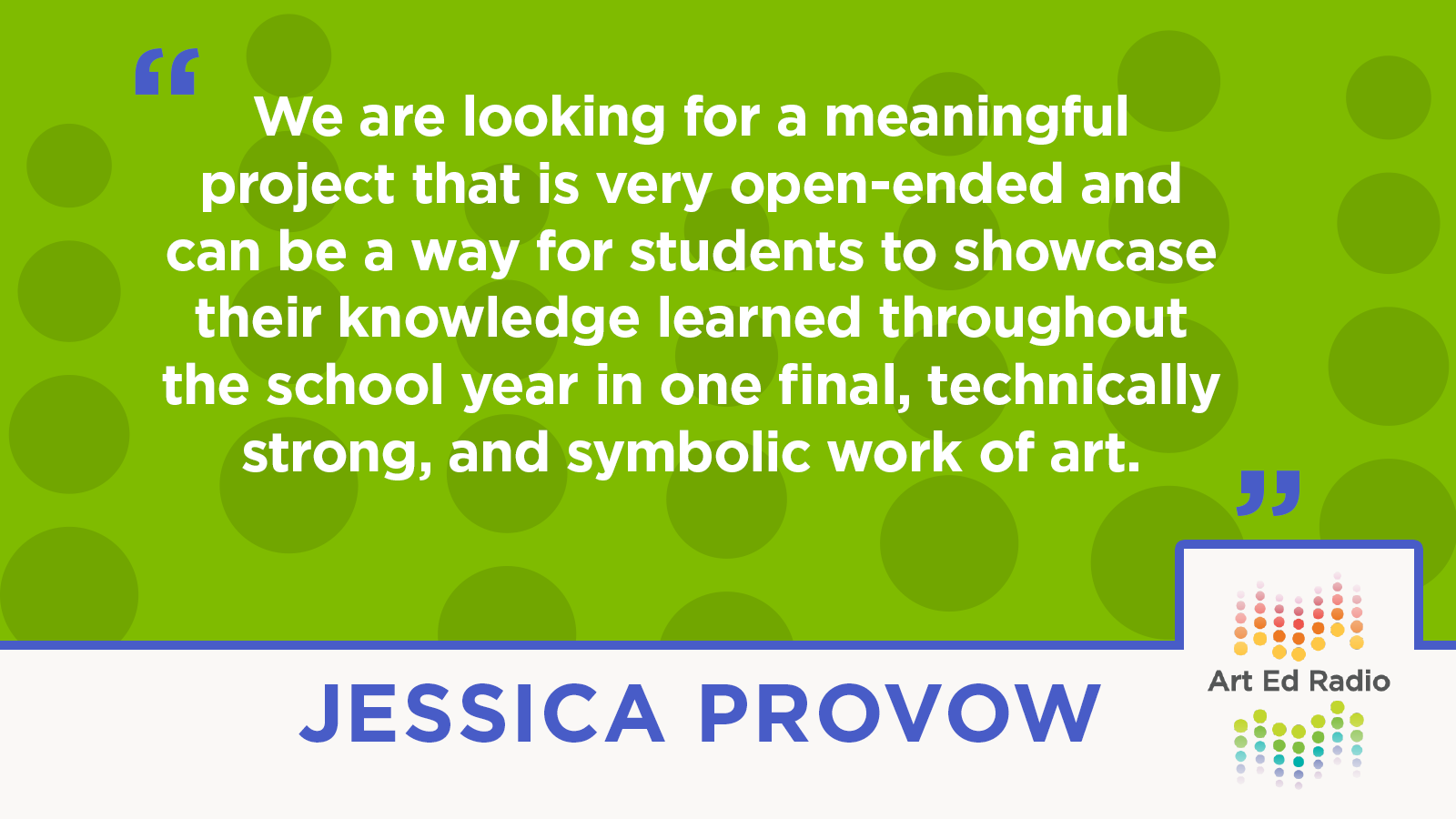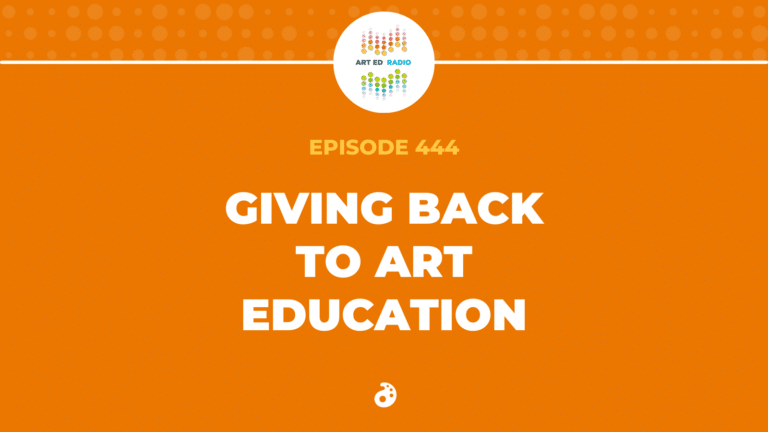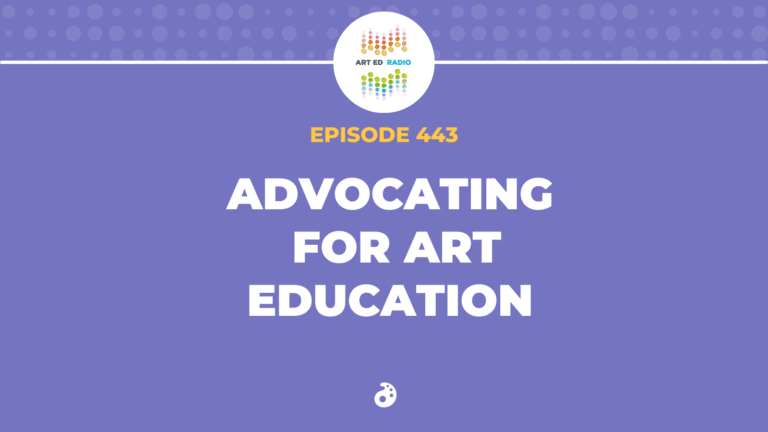If you are looking for a good way to wrap up your school year, why not consider a favorite teacher portrait project? In today’s episode, Jessica Provow joins Tim to talk about her final project for her students that is both meaningful and challenging, and also shows appreciation for staff members throughout the school. Listen as they discuss sketchbook work and project planning, showing teachers appreciation, and how students can leave a legacy at their school. Full Episode Transcript Below.
Resources and Links
- Follow Jessica on Twitter
- Read more about the portrait project
- Check out The Art of SEL podcast from AOEU

Transcript
Tim: Welcome to Art Ed Radio, the podcast for art teachers. This show is produced by The Art of Education University, and I’m your host Tim Bogatz.
As we move toward the end of the year, a lot of teachers are still looking for a project to close things out or a good idea for a successful project to finish out this long year. And I think we may have something for you today. My guest will be Jessica Provow, who does an amazing project that she and her colleagues came up with. And I’ll let her tell you all about it. But basically, it is a wonderful project that helps her students honor and show their appreciation for the people that they see and learn from every day. I’m excited for you to hear about it.
But before we start the interview, I want to talk about our newest podcast, which is called The Art of SEL. The first episode, which came out yesterday, it’s an entire mini-series all about social and emotional learning in the art room. And I’m really excited about this one. You may have heard the trailer last week at the end of Art Ed Radio or you may have run across it sometime in the past week on social media or the AOEU website, but yesterday the first episode was published. And in that first episode, Jonathan Juravich, who is an amazing host by the way, talks about the importance of social and emotional learning and the role we can play as art teachers. It’s a great start to this area, it’s the first of eight episodes, like I said. And I cannot recommend it highly enough. So you can find The Art of SEL on the AOEU website or your favorite podcast app, and we will link to it in the show notes as well.
But listening to that can come later. So right now we need to talk about great ideas and great projects and a powerful portrait project that might be a good way for you to end your year. So let me welcome on Jessica Provow.
All right, and Jessica is joining me now. Jessica, how are you?
Jessica: Hi. I’m good. Thank you.
Tim: Good. Glad to hear it. We have a lot of cool things to talk about today. I’m super excited. But before we jump in, can you just kind of introduce yourself, tell us a little bit about yourself and your teaching.
Jessica: Yeah. Awesome. So thanks so much for having me. I’m Jessica Provow, I’m an art teacher from Virginia Beach. I’ve actually been teaching for 10 years now. And I’m part of a gifted visual arts program that consists of five teachers and the program supports both elementary and middle school students. And I am housed at the middle school level and I’ve been there for a few years now. And we actually teach following the Art Foundation high school objectives.
Tim: Okay.
Jessica: And these kids, they’re incredible. They’re so incredibly talented and it comes very natural to them. And my husband always describes my job as teaching the next da Vincis or Frida Kahlos, and I think he’s absolutely right.
Tim: Yeah. I love that. That’s a good way to phrase it. That’s a good way to kind of think about what we do. So I like that. And then can you tell us a little bit about just what this year has been like for you? Have you been doing distance learning? Are you a hybrid? Are you teaching in person? How has this year been going for you?
Jessica: Sure. Yeah. So like most this year, it’s definitely been a unique one. It started off all virtual and eventually transitioned to hybrid teaching. So I teach students who are physically sitting in my art room for 90 minutes while concurrently teaching to a group of students through a computer who are sitting in their homes. So we had to make up a bunch of art kits that go home so the virtual kids have the same supplies and creative choices as the in-person kiddos.
It’s definitely been a hard year on everyone, but my students have been resilient and they found a space to be creative. Honestly, I am truly in awe of what they can accomplish even under the most stressful situations. And what’s so cool about our program is many of these students have been together in their art classes since third grade. So they really are like a tight knit family and they look out for one another. And this year, I think in particular, they’ve had to look out for one another.
Tim: That really pays off. I don’t know. I’ve talked a lot on this podcast about the benefits of building community and trying to have that in your classroom. And I think, though we’ve seen those sorts of things pay off this year where kids really want to support each other. They really want to help each other. So I’m glad to hear that’s kind of taken hold for you and your kids.
Jessica: Yes.
Tim: And then I wanted to talk just a little bit. I know we have the big idea about portraits that we’re going to jump into, but I wanted to ask about a couple other things I’ve seen on social media that I really love. I wanted to ask how you get your kids to make such incredible work in sketchbooks. The stuff that I’ve seen just blows me away, especially for the level you’re teaching. So can you talk a little bit about your process for sketchbooks in your classroom, for planning, for idea development that you do with your students?
Jessica: Sure. Yeah. Thanks so much. The sketchbook development it’s a big part of our program. It’s something we instill in the students really early on. And it’s a way to showcase their creative process, so me as their teacher but also their peers can see their ideas and be able to critique those ideas.
So what we have them do is on one page of their sketchbook or on a two-page spread, they create a concept mind map, three thumbnail sketches. They experiment with media and showcase color choice. So all of our projects are conceptually based yet students have choice in the way they visually showcase that over arching concept in their art work. Projects are also connected to historical or contemporary artists who works in the same media or around the same concept. And this inspiration really helps them see the possibilities and limitations of what’s currently out there in the art world.
Tim: Right.
Jessica: And so while researching these artists, they also put that into their sketchbook and then having students practice with their media and their sketchbook really encourages experimentation without fear of failure. So simply practicing and exploring before taking on a larger assignment. So students really work in their sketchbook in this manner prior to every large project. So for them, it’s second nature now it’s all just part of the visual process. I mean, don’t get me wrong though sometimes it’s like moans and groans. Groans are heard especially from the newer students, but it’s such a repetitive and concrete way to plan and prepare that students they catch on. Right. They realize it’s useful now. And they began to really get into the design aspect of their page. So we could start to see some future like graphic designers, which is neat.
Tim: I think that’s the big fight that we’re always in the big battle or trying to fight with our sketchbooks is just having kids see that it is useful. It is helpful. It really… it has consequences when you move to bigger work, it can be incredibly beneficial. And so I think if you can win that battle, you’re most of the way there. But then of course, I need to ask you the big reason I wanted to have you on was to talk about these amazing portraits that your students are doing. So can you just tell us about the portrait project that you do with students and how the staff members around your school play a small part in it I guess?
Jessica: Yeah. Yeah. So the project is we call it a teacher-inspired artwork. And it was initially designed by art teachers on a whim many years ago. And since then it has evolved into this crammed assignment that’s a permanent addition to our eighth-grade curriculum. And this is the type of project that both students and staff members always look forward to. And it’s not necessarily a focus on portraiture. Although many students do choose to take it in that direction. It’s simply a focus on creating an artwork for a teacher or staff member who inspired the student during their middle school career. So this could be anybody from bus drivers, core teachers, elective, guidance counselors. So someone who impacted their school life. So what they do is students choose someone who maybe teaches their favorite subject or someone who actually made them enjoy their least favorite subjects.
It could be someone who has been there for them emotionally who made them feel safe and happy, or simply someone who said hi and good morning to them. So this project is their final artwork for their eighth-grade year. And during the introduction of this project, we go over symbolism through imagery and color and how this can be helpful when trying to create an artwork like this. And within their sketchbook planning process, they choose a 2D technique to demonstrate. They also have a choice in media and they develop symbols associated with their chosen individual. And at this point in the curriculum, like I said, it’s the very end of the year. So they’ve learned 2D, 3D, everything, and really have an understanding of compositional techniques and color and emotion. So this project is very open-ended and it’s a way for students to showcase their knowledge learned throughout the school year in one final, technically strong and symbolic works of art.
So the artwork once complete, it actually hangs in the hallways of the school as the final end-of-the-year exhibition. And it stays there throughout the summer and into the start of the next school year, which is great. So like many people, staff, students and community members get to actually view this artwork. And then once the work is taken down, they’re actually given to the teacher or staff member as a thank you from the student. It’s also the students, moment they leave behind because many teachers choose to hang the artwork in their classrooms on permanent display.
Tim: Wow. That’s really cool. Yeah. I love the idea that it is so open-ended where you’re letting kids choose who they’re going to do, what media they want to use, but yet you’re still giving them the structure as far as, doing the symbols and figuring out techniques and going out. I think that’s a really, really good way to organize it. And obviously the emotional connection that that’s there with whoever the subject is, has to be amazing. But I want to ask, how do students generally react to the project? Like, is this something they enjoy working on? Do you think they like feel pressure to, I don’t know, like get it right for lack of better words.
Jessica: Yeah. Yeah. Students love this project since it’s something we have done for many years now, they’ve seen previous examples of it in the hallway. So they know it’s coming, when we get closer to the end of the year and they just get super excited about it. They love working on it. They love the artistic freedom and the media and the design choices. And it really allows them to pull in their own interest and truly explore how they want to showcase themselves as artists.
There is an amount of pressure attached to this project, but over the years, I’ve always gotten the sense that it only helps drive the students to create strong works of art, art worthy to give their inspirational teacher. So within this project, I tend to see really strong work ethic and focus even in the students who may not typically always demonstrate these qualities. And I do believe it’s attributed to students wanting to get it right, like you said, or make it perfect. It’s definitely a big ask for students to pour their time, creative energy and talent into an artwork that they then will hand over to another individual. It’s very personal. It’s also very generous. And I think they want to create a work of art that is equivalent to the educational, knowledge, lab and support that their chosen individual gave to them during their middle school career.
Tim: That’s a great way to think about it, sort of that reciprocity. That’s really cool. And then like how do staff members react like when they receive these portraits or even when they see them for the first time? Like how do they react? Are there any good stories that you can share?
Jessica: Sure. So actually at the beginning of this assignment students had to develop a Q and A interview style document and send it to their teacher or interview their teacher. And these questions range from like educational questions, personal, even humorous and silly ones. Like if you were an ice cream flavor, what would you be? The range of questions really gives the students a full view and understanding of their chosen person. You know, now they’re not just the teacher who lives at the school and sleeps at the school, eats at the school but they have an interest. And they use all this knowledge to formulate design ideas for the final artwork. Once the artworks are complete we wrap up the project with kind of a unique artist statement. These statements are more of a thank you letter than an explanation of the artistic expression. They explain the symbolism and intentionality of the design composition. It’s really about why that student chose that teacher or staff member. And what impact they had on them.
So when artwork is complete students hand deliver the works of art and the statements to the individual. A photo is taken of the teacher on the artist and then we post that along side the work for display. And these moments are such a beautiful and ceremonious way to end the year. Teachers are usually crying. Pre-covid there was definitely hugging, and smiles from everyone. It’s really cool, and on the receiving end of one of these works of art, I can tell you from experience, it’s simply magical. I am always surprised if my name is selected for this project. I mean after teaching these kiddos for three years, I just assumed they’re sick of me by now. But that moment when an art kiddo gives me that work of art and you get to see everything that they poured into it. It’s beautiful. And I think one of the best ways like a teacher or a staff member could ever be recognized.
Tim: Yeah. I think that’s wonderful. I think that’s beautifully put. Jessica, thank you so much for sharing everything about this project, everything that goes into it and just kind of letting us kind of see into what you’re doing. I think it’s a really amazing thing. So thank you for sharing it with us.
Jessica: Of course thank you.
Tim: Thank you so much to Jessica for giving us some time and sharing all about what she’s doing with her colleagues, sharing everything that goes into those projects. And even a little bit about the artmaking process that she facilitates with her middle schoolers. We will link to Jessica’s Twitter and if you’re interested, you can see a little bit about those sketchbooks there. A few examples of the portrait project that we discussed and a few other things that are going on in her art program. So this has been a quick episode, but I think it has been a good one and I hope it might be able to give you what you need. If you’re looking to put together a meaningful project to end your school year.
Art Ed Radio is produced by the Art of Education University with audio engineering by Michael Crocker. Thank you for listening. And one last reminder here, to go listen to the Art of SEL with Jonathan Juravich. Check it out on the AOEU website or search for it in Stitcher, Spotify, Apple podcasts, wherever you subscribe to this podcast, check that one out as well. Give it a chance. I think you will enjoy it.
Magazine articles and podcasts are opinions of professional education contributors and do not necessarily represent the position of the Art of Education University (AOEU) or its academic offerings. Contributors use terms in the way they are most often talked about in the scope of their educational experiences.



